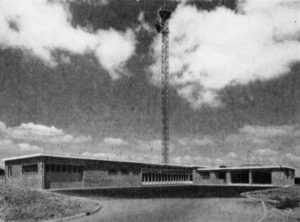South-West England

Westward Television is the company which under agreement with the Independent Television Authority provides the television programmes in South-West England during the whole week.
Derry’s Cross, Plymouth.
PLYMOUTH 69311
4-7 Woodstock Street, New Bond Street, London W.1.
HYDe Park 8262
ITA Channel Vision Sound Opening Date Population ITA Homes
Transmitter Frequency Frequency 000's 000's
Mc/s Mc/s
Stockland Hill 8 194.74325 191.234 29th April 1961 }
} 1,601 294
Caradon Hill 10 209.74325 206.23 29th April 1961 }
Directors
Peter Cadbury (Chairman and Joint Managing Director); WH Cheevers (Joint Managing Director (Plymouth)); Sir John Carew Pole, Bart, DSO, TD, VL, JP and Sir George Hayter Hames, CBE, MA, DL, JP (Joint Vice-Chairmen); RP Baker, FCA, FRSA; W Brimacombe, OBE; Lady Browning; H Michael Chapman; Dr JW Cook, FRS; The Countess of Eldon, OBE; WA Hawkins, OBE, JP, FCA; Frank Hoare, CBE; Baynham Honri, FRPS, Hon FBKS; GH Lidstone; Emile Littler; Stephen Mitchell; Sir Godwin Michelmore, KBE, CB, MC, TD, DL, JP; The Lord Netherthorpe; Col E Palmer; Geoffrey Phillips (Sales Controller); The Hon J St Aubyn, DSC; Sir Clifford Tozer, JP; The Viscount Vaughan, MA.
Officers
G Bloomer (Executive Controller); T Singleton (Head of Planning and Presentation); HK Lewenhak (Head of Production); RR Miller (Company Secretary); GG Affleck (Chief Accountant).
Staff
Total number of staff is 206. Of this number 160 are at the Plymouth studios and the remainder at London.
Visits to Studios
Visits are permitted on a regular basis; applications must be made in writing to the Executive Controller. Applications for show tickets and contestant vacancies must be made in the first instance to the Executive Controller.
Programme Journal
Look Westward publishes details of the programmes available in the area.
Studios
STUDIO 1. 2,500 sq. ft. incorporating the latest type of lighting grid. Mole-Richardson telescopes operate from above, allowing suspension of lamps at any point in the studio and leaving the floor completely free of any lighting equipment. Lighting is controlled by a Strand Console with facilities for preset lighting plots. The studio equipment consists of three Marconi Mk. IV I.O. cameras, Vinten Pedestals, and a tracking dolly; Marconi minor sound mixer with 11 inputs, disc and tape reproducers; and an 8-channel Vision Mixer with special effects, etc.
STUDIO 2. 400 sq. ft. approx. with ample facilities for news, sports and interview-type programmes. Two Marconi Mk. IV I.O. cameras, mobile 8 channel sound and vision mixer which can be easily de-rigged for O.B. use. Additional facilities which are available for general use from time to time include B.P. (Back Projection).
TECHNICAL AREA AND MASTER CONTROL. The Master Control Room is a highly versatile and efficient unit comprising a small presentation studio in which a Marconi Vidicon and Zoom lens is mounted, and a control desk and monitors. Also in Master Control is the mater clock which provides the accurate impulses to synchronise all the step-seconds clocks in the technical areas. The personnel required to operate the M.C.R. are usually one Presentation Engineer and a Logging Clerk. Special effects, inlay, mixes, front projection and children’s live linking using the animated and celebrated rabbit, Gus Honeybun, are all produced in M.C.R.
Adjoining M.C.R. is the telecine and videotape recording area in which two flying spot and two Vidicon telecine channels are mounted. Two R.C.A. V.T.R. machines and a Pye caption scanner complete the programme source equipment, but the main pulse, video and sound distribution and switching equipment is also mounted in racks adjoining the telecine machines.
At one end of the technical area is the large maintenance workshop which is well equipped with test instruments and a technical store.
ATHENAEUM THEATRE. Adjacent to the studio block is a privately-owned theatre, permanently wired for TV, with seating accommodation for 300. This can be used as a studio in conjunction with the Control Rooms and all the basic facilities of Studio 1.
Film Department
All film is handled in Plymouth and a comprehensive film department includes facilities for making up commercials and feature films, processing and editing local film material, and preview theatre and library.
Technical Developments
33 mm. telecine projectors are being modified locally to run silent films at 16 frames per second. In connection with videotape recording, a frame and line phasing unit is being built to allow the insertion of tape recorded items into studio production.
Programmes
Westward takes the best of the network programmes, whilst those produced locally include Westward Diary,a topical magazine programme about the Westcountry which is transmitted three nights a week; News; Postscript, a news review of the week in the Westcountry; Conflict of Opinion, a weekly discussion programme; Westward Sports Desk, twice a week; Treasure Hunt, a weekly quiz; Home Town, inter-schools; Stars in the West, “pop review”; Faith for Life, a nightly religious talk.
News Coverage
Westward News covers an area stretching from the Isles of Scilly in the West through the whole of Cornwall and Devon to Weston-super-Mare in the north-east to Weymouth in the south-east. During a week 55 minutes of news bulletins are transmitted.
To cope with this output there is a permanent staff of four journalists in the News Department. Film, which occupies about half the bulletin, is shot by four freelance cine cameramen under contract to the Company and six other cameramen who do occasional work. The four main cameramen are based at Penzance, Lydford, Exeter and Taunton, thus being in line along the backbone of the region. The other six cameramen are based at Liskeard, Plymouth, Torquay, Chard, Weymouth and Bristol. News is provided by a total of 70 correspondents.



